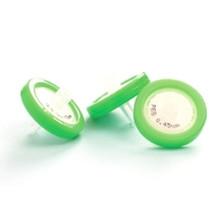Posted by Chrom Tech on 28th Oct 2025
A Complete Guide to Syringe Filters: How They Work and How to Use Them
By Chrom Tech – Your Chromatography Consumables Partner Since 1983

Table of Contents
- Overview
- How Syringe Filters Work
- How to Use Syringe Filters
- Benefits and Applications
- Frequently Asked Questions
- Why Choose Chrom Tech
Overview
Syringe filters are a vital part of chromatography workflows, protecting expensive HPLC, GC, and IC systems from particulates while ensuring high-quality analytical data. Whether clarifying solvents or preparing biological samples, these disposable filters safeguard your instruments and enhance reproducibility. Since 1983, Chrom Tech has provided scientists with premium syringe filters and filtration accessories designed for reliable performance and cleaner results.
How Syringe Filters Work
Syringe filters operate by forcing liquid samples through a membrane of defined pore size. Larger particles are retained on the surface, producing a clear filtrate ready for injection or further processing. The choice of membrane—PTFE for aggressive solvents, Nylon for aqueous/organic mixtures, PES for biological samples, or PVDF for low protein binding—ensures compatibility and accuracy across applications.

How to Use a Syringe Filter
Proper use of a syringe filter ensures clean samples and consistent chromatographic performance. Follow these steps:
- Draw your sample into a clean syringe.
- Attach a Luer-lock style filter for a secure, leak-free connection.
- Hold upright to vent air and gently push the plunger to filter the liquid.
- Collect the filtrate directly into an autosampler vial.
- Dispose of the used filter; syringe filters are single-use only.
Never attempt to reuse or autoclave a syringe filter—doing so can compromise membrane integrity and contaminate future analyses.
Benefits and Applications
- Protects HPLC and GC systems from clogging and contamination.
- Improves data precision, peak shape, and baseline stability.
- Reduces maintenance costs and downtime.
- Ensures reproducibility between runs and instruments.
- Available in multiple diameters, pore sizes, and chemistries to match every sample type.
Chrom Tech syringe filters are engineered to meet demanding laboratory standards for analytical and preparative chromatography, life-science research, and environmental testing.
Frequently Asked Questions
What are syringe filters used for?
They remove particulates and protect instruments during analytical procedures such as HPLC, GC, and IC. They can also sterilize buffers or clarify solvents prior to use.
How do syringe filters work?
Liquid is forced through a membrane with a defined pore size. Particulates larger than the pores are retained, yielding a clean filtrate. Membrane choice depends on chemical compatibility.
Can syringe filters be reused?
No. Syringe filters are designed for single use only. Reuse can cause cross-contamination and loss of filtration efficiency.
Do syringe filters expire?
Yes. Each package includes an expiration date based on material stability. Always check before use, as older filters may degrade or adsorb analytes.
What is a 0.45 µm syringe filter?
A 0.45 µm membrane is the standard choice for general sample clarification. For sterile filtration, choose a 0.22 µm filter.
Where can I buy syringe filters?
Chrom Tech offers a comprehensive range of syringe filters in various membranes, diameters, and pore sizes. Choose filters tailored to your workflow.
Why Choose Chrom Tech
Since 1983, Chrom Tech has supported laboratories with high-performance chromatography supplies and instrumentation. Our syringe filters are precision-manufactured to meet rigorous analytical demands, offering consistent flow, compatibility, and retention. Partner with Chrom Tech to streamline your workflow, reduce downtime, and ensure every injection meets the highest standards of purity and performance.

